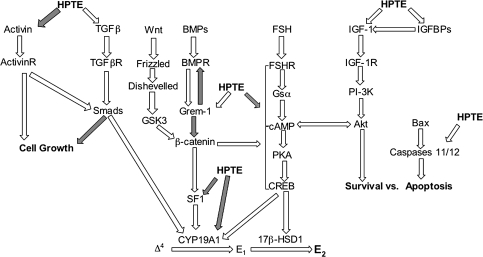FIG. 5.
Proposed model for the effect of HPTE in the granulosa cell. FSH binding to the FSH receptor initiates the PKA signaling pathway that promotes E2 production in granulosa cells. HPTE appears to inhibit this cascade through an unknown mechanism, but effects in multiple pathways are implicated. HPTE affected the expression of several genes known to control granulosa cell function, as described in the text. Among these, activin, TGFβs, GREM1, SF1, IGF-1, IGFBPs, and caspases all have distinct effects in controlling granulosa cell growth, differentiation, survival, and steroidogenesis. White arrows indicate induction. Gray arrows indicate inhibition. Gsα, α subunit of stimulatory guanine nucleotide–binding protein; CREB, cAMP-response element–binding protein; SF-1, steroidogenic factor 1; ▵4, androstenedione; E1, estrone; PI-3K, phosphoinositide 3-kinase; TFGβ, transforming growth factor-β; GSK3, glycogen synthase kinase-3.

